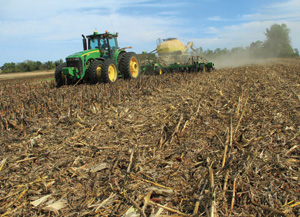
Hessian Fly Free dates across Ohio. Paulding County’s date is September 24
By Andy Michel, Pierce Paul, Kelley Tilmon
The cold temperatures this week reminded us that we are approaching our fly-free date for Ohio. These dates are based on predictions on when most Hessian fly adults would no longer be alive to lay eggs on emerging wheat. Planting winter crops after this date is a good practice to prevent infestations. Areas of Northern Ohio can safely plant wheat after September 22, whereas the dates in southern Ohio extend to October 4 and 5.
The fly-free date can also be used for both cover crops and to manage diseases. A hessian fly can infest certain types of cover crops such as rye and triticale. While we may not worry about yield loss in cover crops, high populations in the winter may provide for infestations in the following spring. For diseases, the biggest advantage and most important benefit of planting after the fly-safe date is a reduction in the fall establishment of Barley Yellow Dwarf Virus (BYDV), Stagonospora blotch, and Septoria leaf spot.
Populations of the aphids that transmit BYDV are usually much lower after the fly-safe date, thus reducing the level of transmission of the disease to the new crop. BYDV tends to be more damaging and causes the greatest yield loss when it becomes established in the fall. For leaf diseases such as Stagonospora and Septoria, planting after the fly-safe date also reduces the risk of fall infections. When Stagonospora- and Septoria-causing fungi overwinter in the leaves, this usually gives both diseases a head-start in the spring, leading to great and earlier damage of the flag leaves before grain-fill is complete, and consequently, greater yield loss if a susceptible cultivar is planted and diseases are not managed with a fungicide.
 LONDON, Ohio – More than 50 companies will join the ranks as exhibitors for the 61st Farm Science Review Sept. 19-21 at the Molly Caren Agricultural Center. The new exhibitors represent various sectors in the agriculture industry including livestock handling, equipment advancements, agronomic technology, agricultural policy, and more.
LONDON, Ohio – More than 50 companies will join the ranks as exhibitors for the 61st Farm Science Review Sept. 19-21 at the Molly Caren Agricultural Center. The new exhibitors represent various sectors in the agriculture industry including livestock handling, equipment advancements, agronomic technology, agricultural policy, and more.
 Join the Digital Ag Team as they dive into research results from around the state of Ohio based on the 2021 eFields report. Registration is free but required. Have you been enjoying the 2021 fields Report and are excited to learn more? Join us to learn more about the eFields program and the results we are seeing across the state.
Join the Digital Ag Team as they dive into research results from around the state of Ohio based on the 2021 eFields report. Registration is free but required. Have you been enjoying the 2021 fields Report and are excited to learn more? Join us to learn more about the eFields program and the results we are seeing across the state.

 lication for the 2021 Ohio Wheat Performance Trials has been finalized and is attached as a PDF file. This article will be published in the mid-August issue of the Ohio Country Journal. All of these results are also available online at the wheat performance trials website:
lication for the 2021 Ohio Wheat Performance Trials has been finalized and is attached as a PDF file. This article will be published in the mid-August issue of the Ohio Country Journal. All of these results are also available online at the wheat performance trials website:  By Jason Hartschuh, OSU Extension Educator, Crawford County
By Jason Hartschuh, OSU Extension Educator, Crawford County




 By Mark Loux, OSU
By Mark Loux, OSU

 Yield results for the 2020 Ohio Wheat Performance Test are online at
Yield results for the 2020 Ohio Wheat Performance Test are online at 
